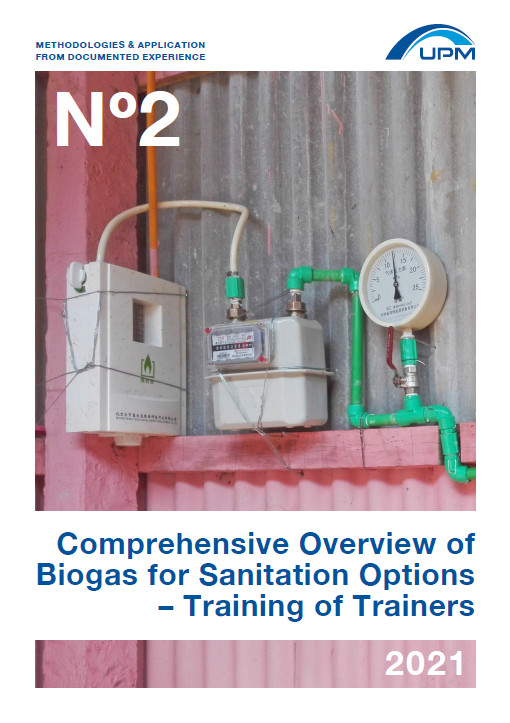Comprehensive Overview of Biogas for Sanitation Options – Training of Trainers
 |
publication coll. Methodologies & Application from documented experience n° 2 Feb 2021 ; 74 pages
Ed. UPM - Munich
Téléchargeable sous format: PdF
Téléchargeable chez l'éditeur
Page de présentation d'un éditeur
Abstract:
The present manual focuses on the systems treating black water, brown water, excreta, faecal sludge, wastewater from low or no flush toilets, and organic kitchen waste - biogas sanitation systems for short.
The main advantages of the anaerobic treatment process compared to the aerobic treatment process are not only the generation of biogas and significantly less sludge production. The fact that the plan t nutrients, phosphorus and potassium, are not removed during the treatment is an additional advantage: it allows for the application of the sanitized nutrient- rich effluent and digestate from biogas s ystems in gardening and agriculture to replace chemical fertilizer. However, it is important to guarantee that the effluent would never be dis charged directly into water bodies without further treatment.
Biogas is a mixture of carbon dioxide (CO2) and methane (CH4). It can be used as a renewable energy source for cooking or for generating electricity, thereby replacing other fuel sources. Contents:
1. Introduction 1
2. Glossary 2
3. Objectives of the Biogas Training Manual 4
4. Training Methodologies, Techniques & Tools 5
4. 1 Elements for a Participatory Interactive Training Approach 5
4. 2 Examples for Questions & Answers 6
5. Training Schedule (Example) 8
6. Training Topics 9
6. 1 What are challenges for sanitation in your place? 9
6. 2 What do you know about biogas technology? 10
6. 2. 1 What is biogas? 10
6. 2. 2 Biogas and the global carbon cycle 10
6. 2. 3 Biology of methanogenesis 10
6. 2. 4 Substrate and material balance of biogas production 10
6. 2. 5 Policy 10
6. 3 Potential strengths and weaknesses of biogas technology in your place 11
6. 4 Biogas Technology: Principles and Practices 12
6. 4. 1 Basic Parameters to be Considered in the Design 13
6. 4. 2 How can biogas technology improve sanitation in a camp of large scale? 18
6. 4. 3 Biogas technology and feeding materials: What is important to know? 19
6. 5 Design of a Biogas Plant, Intermediate Settlers and Mode of Calculation 20
6. 5. 1 Biogas Plant Design 21
6. 5. 2 Design Example: The Fixed Dome Biogas Plant 21
6. 5. 3 Input Material and Its Biogas Potential 22
6. 5. 4 How does the mix of organic matter and water behave in a biogas plant? 22
6. 5. 5 Design Criteria 23
6. 5. 6 What is standardized in a fixed dome plant design? 24
6. 5. 7 More standardized elements 25
6. 5. 8 Never standardized components 26
6. 5. 9 Gas outlet pipe options 26
6. 5. 10 Functional Zones (Caps) in a Fixed Dome Digester 27
6. 5. 11 Design Calculation for a Fixed Dome Digester 28
6. 5. 12 Other Digester Dimensions 29
6. 5. 13 Biogas Potential of Wastewater and per Person 35
6. 5. 14 Modification of Gas Appliances 36
6. 5. 15 Solid-Free Sewer System; Intermediate Settler 37
6. 5. 16 Advantages of the Fixed Dome Model 40
6. 6 Gas production 40
6. 7 Digester sizes: in-situ or prefab designs? 42
6. 8 How to fit digesters in the landscape? 45
6. 8. 1 Channel system to distribute overflow by gravity 46
6. 8. 2 Bananas in Planted Gravel Filter 46
6. 9 Effluent Management 47
6. 9. 1 Introduction: Meaning & Composition of Slurry 47
6. 9. 2 Possibilities for Slurry Utilization 49
6. 9. 3 Slurry as Organic Fertilizer 50
6. 9. 4 Soil Conditions Inducing Nutrient Deficiency in Crops 50
6. 9. 5 Application Forms 51
6. 9. 6 Result: Field Trial in Manikganj, Bangladesh 52
6. 9. 7 Advantages of Slurry Practice 52
6. 9. 8 Slurry Practice in Bangladesh 53
6. 9. 9 Prospects of slurry from view point of Trainees 58
6. 9. 10 Hygiene aspects of biogas plants 59
6. 10 Test of Knowledge: Right-or-Wrong Game 60
6. 11 Training Programme Evaluation Form 61
7. Credits 62
Mot clef: |
Editeur/Diffuseur: |
|
UPM
-
UPM Umwelt-Projekt-Management GmbH - Munich - Allemagne |
En cas de lien brisé, nous le mentionner à communication@pseau.org